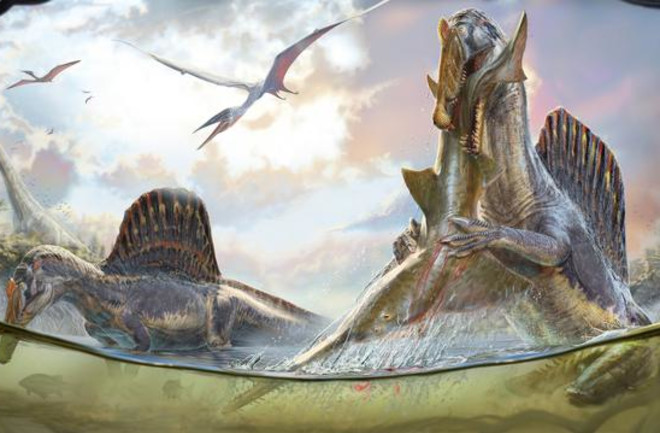The Spinosaurus, a dinosaur with a large dorsal fin, narrow skulls, and crocodile-like jaws, has fascinated scientists for years. It’s accepted that the Spinosaurus was semi-aquatic, and paleontologists suspect the theropod ate fish and lived in what is now Africa during the late Cretaceous. But how the dinosaur captured its prey is controversial, and there are many ideas.
Could it have chased after its prey in the water, snatched up fish with its claws, or dipped its head into the water like an ambush predator? A new study published in PLOS ONE challenges a previous study published in Nature that found the Spinosaurus would chase after prey in the water. Recent research says this may be inaccurate.
Read More: Could Spinosaurus Really Take On T. rex? And Other Facts
Controversial Bones of the Spinosaurus
This is not the first time the looks of the Spinosaurus have changed. It isn’t easy to pinpoint what the Spinosaurus was like. Paleontologists have few bones to examine, and the few that were excavated in 1912 were ruined in World War II.
Before, in the early 20th century, scientists thought this dinosaur had meaty, long hind legs like a Tyrannasaurus rex and didn’t venture into the water. More recent evidence found that the dinosaur might have had stubby legs and a paddle-like tail and lived in or around water instead.
Many studies infer that the Spinosaurus waded in waters near the shore for a quick bite to eat. Some paleontologists argue that its small nostrils in the middle of the skull allowed the dinosaur to breathe when its head was partially out of the water. Its snout was also like a crocodile’s, where they could sense movement in water. The dinosaur’s legs could have allowed it to paddle and its back dorsal fin could have been used to capture prey underwater.
Read More: What Do The Reconstructed Brains of 125-Million-Year-Old Spinosaurs Tell Us?
Bone Density in Dinosaurs
The study's goal was not to find out how the Spinosaurus lived but to reexamine the study in Nature. In Nature, the team used the density of bones to see if the Spinosaurus was semiaquatic. Researchers specifically measured the rib and longer bones because the bones of animals that swim fast and pursue prey in the water have a lower bone density.
The authors of the study in PLOS ONE say that this research was inaccurate. While measuring ribs and longer bones for density works in mammals and reptiles, it’s different for birds and dinosaurs, since they have hollow bones and bones filled with small air sacs.
Because of this, researchers are calling for future studies to use caution when using a smaller sample size and some methods for understanding bone density.
Article Sources
Our writers at Discovermagazine.com use peer-reviewed studies and high quality sources for our articles, and our editors review for scientific accuracy and editorial standards. Review the sources used below for this article:
PLOS ONE. Diving dinosaurs? Caveats on the use of bone compactness and pFDA for inferring lifestyle.
Natural History Museum. Spinosaurus.
Paul Sereno, University of Chicago. Spinosaurus.

